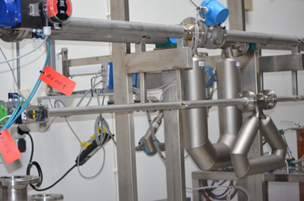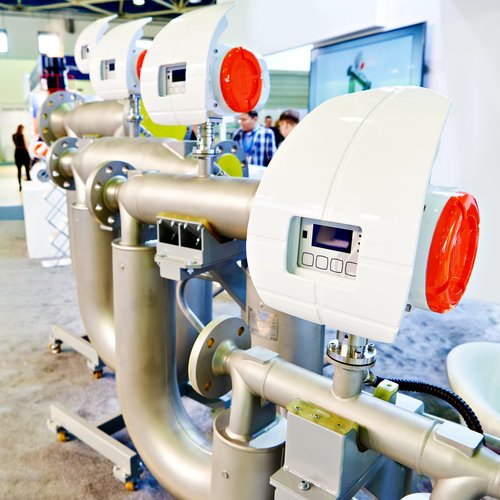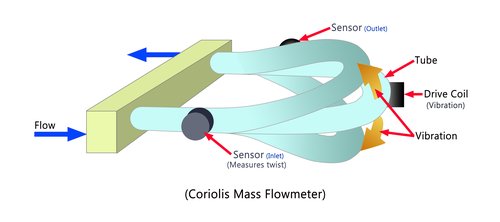|
Flow Research
has completed a new study on the worldwide
Coriolis flowmeter market, one of the fastest growing flowmeter markets,
and this groundbreaking new study reveals the size of the 2024
worldwide Coriolis
flowmeter market, including market shares of all major suppliers. The study
contains forecasts for the market through 2029. It was published in August 2025.
The World
Market for Coriolis Flowmeters, 8th Edition
builds on studies Flow Research published in 2001,  2003,
2008, 2013, 2016, 2020, and 2023. We are determining: 2003,
2008, 2013, 2016, 2020, and 2023. We are determining:
Worldwide supplier market size and shares for Coriolis flowmeters in
2024 with informed data for 2025
Market growth forecast through 2029
Industries and applications where Coriolis flowmeters are used,
including market growth sectors
Strategies for manufacturers for selling into the Coriolis flowmeter
market
Company profiles and product analysis for the main Coriolis suppliers
Product descriptions and average selling prices in the market

The popular
Coriolis flowmeter requires little maintenance and is highly accurate --
many Coriolis flowmeters achieve 0.1% or even 0.05% accuracy. In addition, Coriolis
flowmeters can measure mass flow, which is useful for products sold by
weight rather than by volume and for chemical reactions that are based on
mass rather than volume. Process plants are increasingly selecting Coriolis
meters to replace differential pressure (DP) devices. Mass flow is
especially appropriate for measuring gases, which are more readily affected
by temperature and pressure than are liquids, and their use is growing in
the oil & gas industry.
Companies
that need flowmeters for custody transfer, or want highly accurate
measurement of mass, have a good reason to select Coriolis flow meters. They find that despite a relatively high price tag,
Coriolis flowmeters can provide a good return on investment.
How they work
The roots of
todays Coriolis flowmeters can be traced back to the 1950s. This study
includes a review of the early patents filed in the 1950s, 1960s, and
1970s. it was not until 1977 that Micro Motion was founded and soon
afterwards introduced the first Coriolis flowmeter for laboratory applications. Since that time, a number of other suppliers have
entered the market, including Endress+Hauser, KROHNE, Yokogawa, Rheonik,
and ABB and have
introduced a wide variety of models and types of Coriolis flowmeters.

Coriolis
flowmeters contain one or more oscillating tubes. These tubes are usually
bent, although straight-tube meters are also available now. The fluid to be
measured passes through the oscillating tubes. The momentum of the fluid
deflects the oscillating tubes. Pickoff coils passing through a magnetic field generate a sine wave
on the inlet side and the outlet side. The phase shift or time difference
between the defection in the tubes on the inlet and outlet sides is directly proportional to
mass flow.
Why the Coriolis market is growing fast
A number of
factors are contributing to the growth in the Coriolis flowmeter market:
Custody
Transfer. Custody transfer of natural gas is a fast-growing market,
especially with the increased popularity of natural gas as an energy
source, and Coriolis flowmeters are feeling the effects. Natural gas
changes hands, or ownership, at a number of transfer points between the
producer and the end-user. These custody transfer points are tightly
regulated by standards groups such as the American Gas Association (AGA),
which approved a report on the use of Coriolis flowmeters for custody
transfer of natural gas in 2003. This report, AGA-11, has provided a
significant boost to the use of Coriolis flowmeters for natural gas flow
measurement. The majority of Coriolis suppliers now have meters that can
measure gas flow.
In addition,
suppliers have made a number of improvements in Coriolis technology, and
Coriolis meters are now much better able to measure gases.
Technological
improvements
Suppliers continue to make
technological improvements in Coriolis flowmeters. Straight tube meters
have become more accurate and reliable, thereby addressing some of the
drawbacks of bent tube meters, including pressure drop, the inability to
measure high-speed fluids, and the tendency of bent tubes to cause fluid
build-up.
While bent tube meters still have advantages over many conventional
meters, they do introduce pressure drop into the system. Pressure drop is
an issue because in many cases the fluid has to be speeded up back to its
original velocity. This costs money, as it requires the use of pumps.
Another issue has to do with the tendency for build-up to occur around pipe
curvatures. This can be a special problem for sanitary applications. Having
a bent pipe also slows down the fluid, making it more difficult to meter
high-velocity fluids.
Other
improvements include the use of titanium and other construction materials
that make the meters stronger and longer lasting, as well as a trend toward
flowmeters that can effectively handle larger line sizes. More than any
other meter, Coriolis meters have line-size limitations. Due to the nature
of the technology, Coriolis meters get large and unwieldy once they reach
the six-inch size. Even two-inch, three-inch, and four-inch meters are
quite large. Rheonik has combined two six-inch Coriolis meters to create a
meter that can handle larger line sizes. While it has sold a very limited
number of these meters, it does represent an interesting and creative way
to deal with the line-size issue. Other companies that have introduced
Coriolis flowmeters for line sizes above six inches include Endress+Hauser,
KROHNE, Micro Motion, and Shanghai Yinuo.
Low
maintenance. Even though Coriolis meters have a higher purchase price than many other flowmeters, they may cost less
over the lifetime of the meter due to reduced maintenance costs. Unlike
turbine and positive displacement meters, Coriolis meters do not have any
moving parts, apart from the vibrating tube. They are not subject to wear
in the way that orifice plates are. With many companies reducing their
engineering and maintenance staffs, having a meter that does not require a
great deal of maintenance can be a major advantage.
Lower cost
meters. Micro
Motion, Endress+Hauser, and other companies have broken the price barrier, by offering lower-cost
Coriolis meters in the $4,000 range rather than the more typical
$9,000 to $12,000 range and up (depending on size). The lower price also
means lower accuracy -- published accuracies are in the 0.5% range -- but
these meters give end-users the option to buy into the advantages of
Coriolis technology at a more affordable pricepoint..
Articles about Coriolis
flowmeters
Previous
studies:
The
World Market for Coriolis Flowmeters,
7th Edition
Released in 2023
The
World Market for Coriolis Flowmeters,
6th Edition
Released in 2020
The
World Market for Coriolis Flowmeters,
5th Edition
Released in 2016
The
World Market for Coriolis Flowmeters,
4th Edition
Released in 2013 - Provides historical context
The
World Market for Coriolis Flowmeters, 3rd Edition
Released in 2008 - Provides historical context
The
World Market for Coriolis Flowmeters, 2nd Edition
Released in 2003 - Provides historical context
The
World Market for Coriolis Flowmeters, 1st Edition
Released in 2001 - Provides historical perspective
|